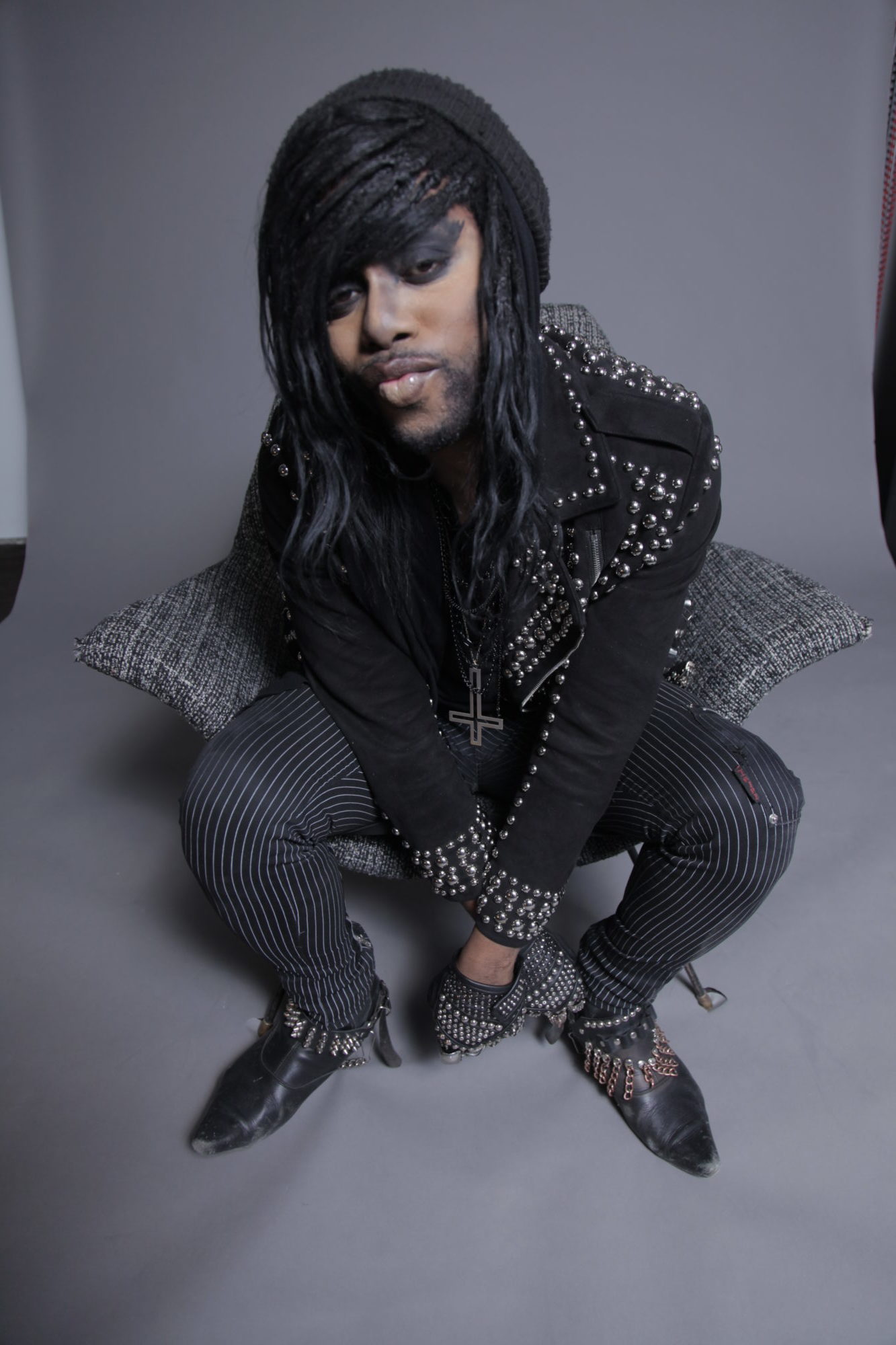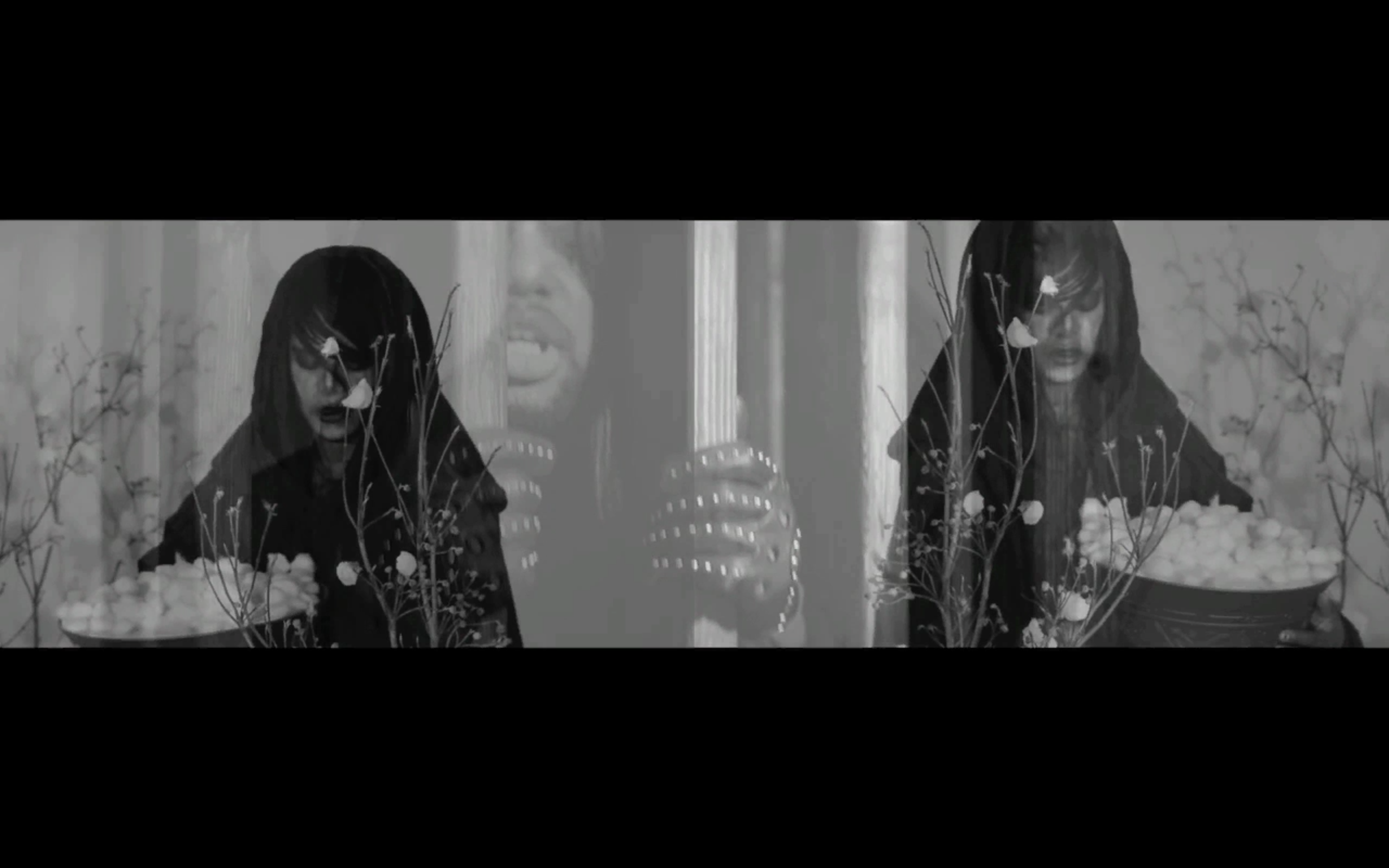M. Lamar: American Cuck
M. Lamar, performance view of American Cuck, at Dixon Place, July 2018 [photo: Sally Hansell]
Share:
As viewers arrive for composer M. Lamar’s multimedia installation American Cuck, a looping video “pre-show” depicts a young white woman with a Carly Simon smile, sitting on a bed with her husband, blithely answering questions from an off-camera interviewer about her sexual experiences with black men. “Having sex with a black man is like driving a BMW 200 miles down the road, down the Autobahn,” she gushes, equating the black male body to a commodity to be exploited. “In the American culture,” she continues, “they expect white women to be very prim and proper, asexual prudes. When I’m with a black man, it brings out, like, the freak in me. It’s, like, primal, the animal instinct thing.” Her passive, pony-tailed husband wishes he could experience the same sexual intensity. This footage sets the premise for American Cuck, which premiered at Vassar College’s Frances Lehman Loeb Arts Center (May 10, 2018) and was performed, in an expanded version, at New York arts incubator Dixon Place (July 12, 2018) as part of “Hot! The NYC Celebration of Queer Culture.”
Lamar describes the 70-minute American Cuck as “a psychosexual portrait of the United States” that explores “the construction of the white male cuckold, the black male object of his obsession, and the relation of both to a plantation culture of race, desire, and violence.” The Brooklyn-based artist has been grappling with the legacy of slavery in his work for the past 10 years. He became riveted when the portmanteau term cuckservative—cuckold plus conservative, or cuck, for short—exploded in “alt-right” social media starting in 2015, during the ascendancy of Donald Trump to the national stage. The slur labels some Republicans as weak for straying from far-right conservative positions on immigration and Confederate monuments, for example, or for simply yielding to pressure. Its popularity with white nationalists is no accident. Historically, white men (generally in North America and Europe) have held fearful fantasies of hypersexual black men raping white women. Internet pornography offers an entire genre in which white men watch their wives in bed with other men—often with black men.
When Lamar sits down at the baby grand, wearing heavy dark eye makeup and lipstick, a black leather jacket, and gloves studded with silver skulls, all part of his “Negrogothic” aesthetic, we enter a completely different world than the comfortable oblivion of the heterosexual couple in the overture. In seeming homage to Diamanda Galás’ agonizing vocal ranges, Lamar plays piano and sings in an exquisitely haunting combination of opera, heavy metal, African American spirituals, and extreme vocalizations.
Portrait of M. Lamar [photo: Wil Adamy; courtesy of the artist]
Like the master of ceremonies at a satanic mass, he chants excerpts from Hegel’s “lordship and bondage” chapter in Phenomenology of Spirit. The text to his singing is displayed libretto-style on the screen throughout the performance. American Cuck invites us to examine our own place in the master-slave dialectic that unfolds in the work’s hellish, dystopian narrative representing North American history, from colonial times to the present.
With art direction and black-and-white video by longtime collaborator Sabin Michael Calvert, American Cuck sets Lamar’s musical compositions and singing in conversation with iconic images of plantation culture. Jail doors repeatedly slide open and shut and then multiply into a grid of cells caging black men: mass incarceration as modern slavery. Lamar poses as an enslaved person, clad in a monk-like hooded robe, the ghosted black male body. The cellblock soon morphs into a plantation where he picks cotton as if in a trance while a toned, shirtless white overseer looks on, cracking a whip. A kiss initiated by the overseer leads to sadomasochistic sex—with the power roles reversed, momentarily. Bullwhip in hand, Lamar stands passively, with no visible affect, between two rows of identical-looking white men who are shaved and bent over with whips protruding from their anuses, an illusion of symmetry created by doubling the image. The artist infuses Robert Mapplethorpe’s 1978 Self Portrait With Whip with about 200 years of history, but the geometry of figures lends a chilly abstraction.
Lamar, screen grabs from American Cuck, 2018, Vimeo [courtesy of the artist]
Crisscrossing the boundaries of place and time, another S&M whip scene is staged in the stacks of a modern archival institution. A geeky young white man solemnly carries a box, sits down with four magnifying glasses, and unpacks a large photograph, which he scrutinizes with the protracted gaze of a scientist: a close-up of a black penis. Ritualistically, he places images on a shelf, arranging knives and whips around them as on an altar, while Lamar sings in an extreme bass baritone mixed with vocal fry: “Put the whip in my hand. Yo my cracker. Let me crack it. Your whip. Your whip is my command.”
“Penis guillotines,” imagined and designed by Lamar as nine-foot devices with a blade that severs whips, appear throughout the footage, speaking directly to the castration occurring in slavery and in lynchings, as well as to the white male obsession with black male genitalia. The black penis returns as a fetish in Lamar’s final bel canto aria, “He cut off my father’s private parts, and he likes to play with mine.” The song fuses opera and spirituals as part of a tradition begun by Roland Hayes, Marian Anderson, and Paul Robeson, one continued by Leontyne Price and Jessye Norman. There is tenderness in this song, suffering and mourning. We must “dwell” or “sit in the grief,” Lamar said in an interview.
As Lamar writes in a description of American Cuck, “any rupture in the dominant masques of the plantation sends the entire republic into crisis. Such ruptures and crises are the focus—and the goal—of this piece.”
Sally Hansell is a freelance writer based in New York’s Hudson Valley. Her reviews and feature articles have been published in Sculpture, artcritical, American Craft, Surface Design, Huffington Post and The Atlanta Journal-Constitution.

